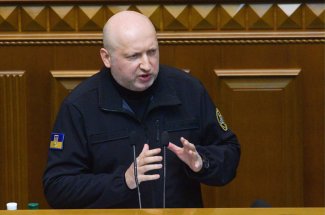Martial law in ten regions of Ukraine

After a heated discussion, the Ukrainian parliament adopted a law during an extraordinary session late in the evening of 26 November approving a decree by President Petro Poroshenko introducing martial law for 30 days in ten regions located along the border of Russia, the coasts of the Azov Sea and the Black Sea, and the borders with separatist Transnistria (the Vinnytsia, Odessa, Mykolaiv, Kherson, Zaporizhia, Donetsk, Luhansk, Kharkiv, Sumy and Chernihiv oblasts).
The bill was supported by 276 deputies in the 450-seat parliament. The introduction of martial law was supported by the Petro Poroshenko Bloc, the Popular Front, Batkivshchyna (although Yulia Tymoshenko did not participate in the vote), the Radical Party and Self-Help; the Opposition Bloc’s MPs were against it.
The text of the bill as adopted is substantially different from the proposal put forward by President Poroshenko. The period of martial law is expected to last 30 days (instead of 60), and will not cover the country, but only the ten regions listed above. The president and his colleagues repeatedly stressed that none of the civic constitutional rights and freedoms provided for in the adopted bill will be limited (although the regulations allowing such practices have not been removed), unless there is an act of open aggression on the part of the Russian Federation. Parliament also adopted a resolution to schedule the presidential elections on 31 March 2019, which fits with the previously planned date scheduled in accordance with the Constitution.
Commentary
- Poroshenko’s decision to introduce martial law was a direct response to the act of military aggression by the Russian Federation on 25 November, resulting in 23 Ukrainian sailors being detained. At the same time, it can be seen as a step dictated by the current political calculation (specifically in the pre-election period), the aim of which was to increase Poroshenko’s chances of being re-elected president.
- The original presidential proposal to introduce martial law met with very strong opposition from parliament. This resistance was aroused above all by the possibility of the suspension of certain rights and freedoms (including the right to property, privacy of correspondence, freedom of expression, freedom of commercial operation) provided for in the Constitution, and of far-reaching restrictions on legal persons (including a ban on demonstrations, the regulation of media operations, the ability to take control of companies). Accusations that these powers could be abused came from representatives of all the parties except the BPP and the Popular Front, which indicates a very low level of confidence in Poroshenko from the political elite. The deputies also raised concern about the fact that the introduction of martial law in the original scenario would have meant postponing the presidential elections by at least one month from the constitutional deadline of 31 March 2019. Finally, the president was forced to withdraw from his original plan and make concessions shortening the period of martial law and reducing the amount of territory it would cover. Although provisions allowing restrictions on the rights and freedoms remained in the text of the law, Poroshenko’s public declarations that they will not be applied will make it difficult for him to use them to combat his political opponents.
- The introduction of martial law should not reflect negatively on Ukraine’s cooperation with the West and international financial institutions. A representative of the International Monetary Fund stated that it has no legal restrictions preventing it from continuing to support Ukraine in the new situation.
- The final shape of the document governing the imposition of martial law in selected regions of Ukraine excluded the proposal to mobilise the reserve forces, which proves that the Armed Forces of Ukraine are not assuming that Russia will start any full-scale military actions in the near future. According to the law, a partial mobilisation may be declared by the President of Ukraine according to the assessment of risk. The law does not formulate specific tasks for the other departments responsible for national security, and is limited to general recommendations to take steps to defend the security and the interests of the state. The State Service for Emergency Situations, responsible for rescue operations and civil defence, has been placed on full alert.




